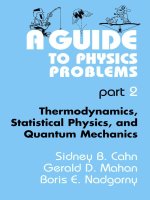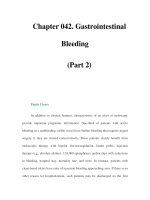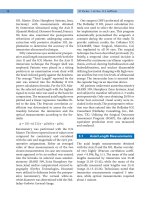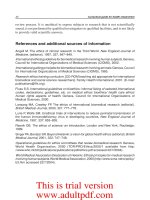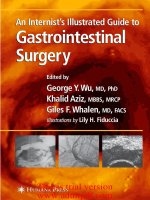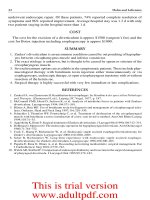An Internist’s Illustrated Guide to Gastrointestinal Surgery - part 2 ppt
Bạn đang xem bản rút gọn của tài liệu. Xem và tải ngay bản đầy đủ của tài liệu tại đây (2.82 MB, 36 trang )
22 Holm and Lafreniere
underwent endoscopic repair. Of these patients, 74% reported complete resolution of
symptoms and 96% reported improvement. Average hospital stay was 1.3 d with only
two patients staying in the hospital more than 1 d.
COST
The cost for the excision of a diverticulum is approx $1500 (surgeon’s fee) and the
cost for Botox injection including esophagoscopy is approx $1000.
SUMMARY
1. Zenker’s diverticulum is an uncommon condition caused by out pouching of hypophar-
ynx between cricopharnygeus muscle and inferior constrictor.
2. The exact etiology is unknown, but is thought to be caused by spasm or stricture of the
cricopharyngeus muscle.
3. Several treatment options are available in the symptomatic patients. These include phar-
macological therapy with botulinum toxin injection either transcutaneously or via
esophagoscopy, endoscopic therapy, or open cricopharyngeus myotomy with or without
resection of the hernia sac.
4. Surgical therapy is highly successful with very few immediate or late complications.
REFERENCES
1. Zenker FA, von Ziemessen H. Krankheiten des oesophagus. In: Handbuch der specciellen Pathologie
und Therapie. (Ziemessen H, ed.), Leipzig: FC Vogel, 1877, p. 187.
2. McConnell FMS, Hood D, Jackson K, et al. Analysis of intrabolus forces in patients with Zenkers
diverticulum. Laryngoscope 1994;104:571–581.
3. Blitzer A, Brin MF. Use of botulinum toxin for diagnosis and management of cricopharyngeal acha-
lasia. Otolaryn. Head and Neck Surg 1997;116:328–330.
4. Schneider I, Thumfart WF, Pototschnig C, et al. Treatment of dysfunction of the cricopharyngeal
muscle with botulinum a toxin: introduction of a new, non invasive method. Ann Otol Rhino Laryng
1994;103:31–35.
5. Aggerholm K, Illum P. Surgical treatment of Zenkers diverticulum. J Laryngol Otol 1990;104:312–314.
6. Dohlman G, Mattsson O. The endoscopic operation for hypopharyngeal diverticula. Arch Otolaryngol
1960;71:744–752.
7. Cook C, Huang P, Richstmeier W, et al. Endoscopic staple assisted esophagodiverticulostomy for
Zenker’s diverticulum. Laryngoscope 2000;110:2020–2025.
8. Scher R, Richtsmeier W. Long-term experience with endoscopic staple assisted esophago-
diverticulostomy for Zenkers diverticulum. Laryngoscope 1998;108:200–205.
9. Papalia E, Rena O, Oliaro A, et al. Descending necrotizing mediastinitis: surgical management. Eur
J Cardiothoracic Surg 2001;4:739–742.
10. Welch AR, Stafford F. Comparison of endoscopic diathermy and resection in the surgical management
of pharyngeal diverticula. J Laryngol Otol 1985;99:179–182.
This is trial version
www.adultpdf.com
Chapter 3 / Esophagectomy for Achalasia 23
23
INTRODUCTION
At length the Disease having overcome all remedies, he was brought into that condi-
tion, that growing hungry he would eat until Oesophagus was filled up to the Throat,
in the mean time nothing sliding down into the Ventricle, he cast up raw (or crude)
whatsoever he had taken in: when that no Medicines could help and he languished
away for hunger, and every Day was in Danger of Death. I prepared an instrument for
him like a Rod, of a whale Bone, with a little round Button of Sponge fixed to the top
3
Esophagectomy for Achalasia
Laparoscopic Heller Myotomy
and Dor Fundoplication
Joshua M. Braveman, MD, Lev Khitin, MD,
and David M. Brams,
MD
CONTENTS
INTRODUCTION
EPIDEMIOLOGY
PATHOPHYSIOLOGY
ETIOLOGY
CLINICAL FEATURES
PATIENT EVALUATION
TREATMENT OPTIONS
SURGICAL MANAGEMENT
INDICATIONS
CONTRAINDICATIONS
SURGICAL TECHNIQUE
COMPLICATIONS
COST OF PROCEDURE
RESULTS OF HELLER MYOTOMY
SUMMARY
REFERENCES
From: Clinical Gastroenterology: An Internist's Illustrated Guide to Gastrointestinal Surgery
Edited by: George Y. Wu, Khalid Aziz, and Giles F. Whalen © Humana Press Inc., Totowa, NJ
This is trial version
www.adultpdf.com
24 Braveman, Khitin, and Brams
of it; the sick Man having taken down meat and drink into his Throat, presently putting
this down in the Oesophagus, he did thrust down into the Ventricle, its Orifice being
opened, the Food which otherwise would have come back again (1).
This observation made by Thomas Willis in 1674 was the first description of a clinical
entity that would later be coined “achalasia” by Sir Arthur Hurst in 1913. Translated
from the Greek, achalasia means, “lack of relaxation” and today refers to a disease of the
esophagus in which the lower esophageal sphincter fails to relax in the setting of a
dilated, aperistaltic, esophageal body. In 1913, Earnest Heller performed the first
esophagomyotomy. The Heller myotomy, with its subsequent modifications, has become
the gold standard for the treatment of achalasia. This chapter will examine the patho-
physiology of achalasia, key elements in the diagnostic assessment, the medical treat-
ment options, and a review of the surgical therapy for achalasia.
EPIDEMIOLOGY
Achalasia affects patients of all age groups. Mean ages range between 30 and 60 years
of age, with a peak incidence in the 40s. It is uncommon during the first two decades of
life and has an incidence of 0.4 to 0.6 per 100,000 with a prevalence of 8–13 persons per
100,000 population (2).
PATHOPHYSIOLOGY
Achalasia is characterized by a hypertensive, nonrelaxing lower esophageal sphincter
and a dilated, aperistaltic esophageal body. Pathologically, the esophagus demonstrates
only minimal dilation early in the course of the disease course but later can become as
large as 16 cm. Histologically, the major abnormality is the loss of ganglion cells in the
myenteric plexus of the distal esophagus. Several other neuropathic lesions are also
observed. These include: a) inflammation or fibrosis of the myenteric plexus early in the
disease course; b) decrease in varicose nerve fibers of myenteric plexus; c) degeneration
of the vagus nerves; d) changes in the dorsal motor nucleus of the vagus; e) decreases
in the number and histology of small intramuscular nerve fibers; and f) occasional
intracytoplasmic inclusions in the dorsal motor nucleus of the vagus and myenteric
plexus. It is unknown where the initial neurological injury occurs (2).
ETIOLOGY
Three basic theories regarding the etiology of achalasia exist: familial, autoimmune,
and infectious. Less than 1% of cases of achalasia are familial, displaying an autosomal
recessive inheritance pattern. Many of the familial cases are associated with consanguin-
eous union. The presence of T cells in the ganglion cells of the esophagus suggests an
autoimmune etiology to the disease. There is an association between achalasia and class
II histocompatibility antigen Dqw1. The similarity between achalasia and Chagas’ dis-
ease caused by Trypanosoma cruzi suggests an infectious etiology. Furthermore, there
is an increased incidence of varicella-zoster virus (VZV) antibodies in the serum of
patients with achalasia as well as the presence of VZV by in situ DNA hybridization in
tissue removed at esophagomyotomy (2).
This is trial version
www.adultpdf.com
Chapter 3 / Esophagectomy for Achalasia 25
CLINICAL FEATURES
The presentation of achalasia depends upon the duration of the disease process.
Most patients are between 20 and 40 years of age with a ratio of men to women of 2:1.
Solid food dysphagia is the most common presenting symptom. Patients describe
fullness of the chest during a meal and a “sticking” in the lower substernal area. Early
in the disease process, the sensation is intermittent but invariably becomes constant.
Food sometimes passes easier when it is warm and the amount of dysphagia can vary
daily. Various maneuvers appear to aid in the passage of food. These include: a) a head
back position in the upright position associated with a Valsalva maneuver; b) drinking
carbonated beverages; c) belching; d) drinking alcoholic or warmed beverages; e) and
smoking marijuana.
Regurgitation is the second most common complaint and occurs in approx 70% of
cases. The regurgitated food is described as undigested, nonbilious and nonacidic, and
frequently awakens the patient from sleep (1).
Other symptoms include chest pain and heartburn occurring in approx 40% of patients.
The pain is described as substernal or epigastric, radiating to the neck, arms, jaws, and
back. Depending of the severity of the symptoms, weight loss is a common feature.
Displacement of mediastinal structures, esophageal ulcerations and perforation, and
aspiration of esophageal contents may also occur (1).
PATIENT EVALUATION
The evaluation of patients with achalasia involves three basic studies: the barium
swallow, upper endoscopy, and esophageal manometry.
The diagnosis of achalasia is often first considered with a barium swallow (Fig. 1),
which classically demonstrates a dilated esophagus and a distal “bird’s-beak” narrow-
ing. This finding, present in 90% of cases, may not be present early in the disease course.
Videofluoroscopy can improve the sensitivity of this study by noting abnormal or absent
esophageal contractions.
Endoscopy should be performed in all patients with achalasia, especially those who
have risk factors for cancer including a greater than 20-lb. weight loss and age greater
than 60 yr. A malignancy of the gastroesophageal junction may present with symptoms
mimicking achalasia, thus described as pseudoachalasia.
Esophageal manometry is the definitive test for achalasia. Patients with achalasia
demonstrate poor relaxation of lower esophageal sphincter on swallowing, lack of
peristalsis in the distal esophagus, simultaneous, low-amplitude, single-peaked, wid-
ened peristaltic contractions, and a positive gastroesophageal pressure gradient.
Computed tomography (CT) scan of the chest, 24-h pH study, and nuclear scintig-
raphy are occasionally utilized. A CT scan of the chest and upper abdomen may reveal
an extrinsic mass or other cause of a pseudoachalasia. The 24-h pH study is used to
diagnose gastroesophageal reflux disease, which is uncommon among patients with
achalasia unless they have received prior dilation or surgical intervention. Esophageal
transit studies using nuclear scintigraphy can be used to assess esophageal motility.
This test is used to assess esophageal emptying after myotomy or dilation.
This is trial version
www.adultpdf.com
26 Braveman, Khitin, and Brams
TREATMENT OPTIONS
It is impossible to restore normal peristaltic function of esophagus. The treatment of
achalasia focuses on relieving the distal esophageal obstruction at the lower esophageal
sphincter (LES). The most common methods include balloon dilation, botulinum toxin
(Botox) injection, and Heller myotomy.
Pneumatic balloon dilation is performed endoscopically with intravenous (iv) seda-
tion. The muscle fibers of the distal esophagus are disrupted without causing perforation
of the mucosa. A volume-limited, pressure-controlled (Gruntzig-type) catheter is placed
across the gastroesophageal junction. The esophagus is then forcefully dilated to a
pressure of 300 Torr for 15 s. A contrast swallow is performed immediately following
to confirm the absence of a perforation
Most people report some symptomatic relief from pneumatic dilation. Approximately
60% of patients have relief of dysphagia and an additional 10% respond to a second
dilation. There is recurrence of dysphagia over time in 10% to 70% of patients requiring
redilation. The incidence of esophageal perforation following dilation is approx 4% with
a mortality of 0.5%. Gastroesophageal reflux occurs in 20 to 40% of patients (3).
Intrasphincteric injection of the LES with Botox through the flexible endoscope rep-
resents a newer modality for treating achalasia. The toxin blocks release of acetylcholine
from the presynaptic parasympathetic nerve endings in the smooth muscle producing a
Fig. 1. Barium swallow demonstrating “bird-beak” narrowing of esophagus typical of achalasia.
This is trial version
www.adultpdf.com
Chapter 3 / Esophagectomy for Achalasia 27
denervation of the LES. The immediate results are excellent, with 70% to 100% of
patients experiencing relief within the first month. However, favorable results are
reported by 60% of patients by 6 mo, and by only 3 to 36% of patients at 1 yr. Repeat
treatments offer transient improvement, but beyond 6 mo, the results are negligible.
Although there are relatively few immediate complications with Botox injection, these
injections induce scarring and inflammation around the esophagus, making subsequent
surgical intervention more difficult (4).
SURGICAL MANAGEMENT
Heller esophagomyotomy is the optimal treatment of achalasia. This procedure
allows for the precise division of the longitudinal and circular muscles of the lower
esophagus, thus relieving the functional obstruction of distal esophagus. Although the
Heller myotomy was first performed transthoracically, the development of video-assisted
minimally invasive techniques has led to the development of a laparoscopic approach
that is equally effective but with minimal morbidity.
INDICATIONS
All patients who can tolerate general anesthesia and laparoscopy should be candidates
for surgery. In particular, patients under 40 yr of age have worse results with pneumatic
dilation, whereas Heller myotomy offers a 90% long-term success rate (5). Patients who
have failed other forms of therapy such as Botox injection or pneumatic dilation are
surgical candidates. These patients may have scarring in the distal esophagus increasing
the difficulty of the myotomy and increasing the mucosal perforation rate, but they have
equivalent outcomes with little additional morbidity (6).
CONTRAINDICATIONS
The surgery is contraindicated in patients with severe cardiopulmonary disease or
other morbidities that will put them at a higher risk for general anesthesia. These patients
may be treated with dilation or Botox injection. Patients with overwhelming cardiopul-
monary risk may be treated with percutaneous endoscopically placed gastrostomy tube
for alimentation.
SURGICAL TECHNIQUE
The traditional approach to Heller myotomy is through a left thoracotomy in the
seventh intercostal space. The distal esophagus and proximal stomach are mobilized.
The longitudinal and circular muscles of the esophagus are incised from the inferior
pulmonary vein across the gastroesophageal junction completing the myotomy a vari-
able distance onto the stomach. The muscle is dissected away from the mucosa allowing
the strong mucosal layer to protrude. A longer myotomy allows complete disruption of
the lower esophageal sphincter, relieving dysphagia but increasing the risk of reflux. To
optimize results, many surgeons add a partial fundoplication to a long myotomy. The
chest is closed with placement of chest tubes. Patients are hospitalized for 4–7 d.
Laparoscopic Heller myotomy is the optimal procedure performed today, with excel-
lent results and minimal morbidity. The procedure should be performed by surgeons
with advanced laparoscopic skills who have experience with this relatively unusual
This is trial version
www.adultpdf.com
28 Braveman, Khitin, and Brams
disease. The surgery is performed under general anesthesia. Five laparoscopic trocars are
placed. The peritoneum overlying the distal esophagus is divided and the anterior esophagus
is exposed after inducing pneumoperitoneum. The anterior vagus nerve is identified and
protected. With laparoscopic magnification, the longitudinal and circular muscles are care-
fully divided, exposing the mucosal layer (Fig. 2). The myotomy is now extended proximally
6 cm from the G–E junction and distally 1 cm onto the proximal stomach. The muscle is
Fig. 2. Schematic of Heller esophagomyotomy. Longitudinal and circular esophageal muscles
are divided from distal esophagus and incision extended to proximal part of stomach and mucosal
layer is exposed.
Fig. 3. Partial fundoplication after myotomy.
This is trial version
www.adultpdf.com
Chapter 3 / Esophagectomy for Achalasia 29
dissected from the mucosa allowing the mucosa to protrude. Intraoperative flexible endos-
copy is then performed to be certain there is no further distal obstruction. The myotomy can
be easily extended if necessary until the lower esophageal sphincter is ablated. Air is insuf-
flated into the esophagus and the distended mucosa is assessed for evidence of perforation.
Once the myotomy is completed, an antireflux procedure is added. A 360°
fundoplication (Nissen) will cause dysphasia. Therefore, a partial fundoplication is
added. Some surgeons completely mobilize the G–E junction and perform a posterior
270° partial Toupet fundoplication. We favor an anterior 180° Dor fundoplication that
protects against reflux, yet does not require disruption of all the phrenoesophageal
attachments (Fig. 3). In the Dor fundoplication, the proximal fundus is sutured to the
hiatus and the divided esophageal musculature (Fig. 4).
The instruments and trocars are removed. The 0.5-cm to 1-cm incisions are closed
with absorbable sutures and Band-Aids
®
. Nasogastric tubes are not necessary. The patient
begins a liquid diet that evening and is discharged the following day. Dysphagia is
immediately improved. The postoperative pain, recovery, and return to work are similar
to that seen in elective laparoscopic cholecystectomy.
Fig. 4. Postoperative barium swallow.
This is trial version
www.adultpdf.com
30 Braveman, Khitin, and Brams
COMPLICATIONS
Complications are uncommon with this procedure. Mucosal perforation occurs in
approx 4.5% of cases. If identified at the time of surgery, it is easily managed with simple
repair of the mucosa. Death is extremely uncommon, reported at 0.1%. Early complica-
tions occur in approx 5% of cases and include pneumonia, deep venous thrombosis,
urinary tract infection, paraesophageal hernia, subphrenic abscess, pleural effusion,
esophageal ulcer, and peptic ulcer.
Gastroesophageal reflux can occur after Heller myotomy. Pathologic reflux can be
subclinical in 50% of patients, but it can be shown on ambulatory pH testing. When
myotomy is performed without an antireflux procedure, reflux occurs in at least 25% of
patients, but it occurs in less than 10% of patients who have a concurrent antireflux
procedure. Reflux should be treated even if subclinical with acid-suppressive therapy to
avoid peptic ulceration and stricture.
Recurrent obstruction may occur as a result of several causes. The patient may have
had an inadequate myotomy or a fundoplication causing obstruction. The patient may
develop a peptic stricture if subclinical reflux occurs. The nature of the obstruction can
be investigated with barium swallow. Forceful dilation or reoperation may improve
these patients. In a few cases, esophagectomy may provide definitive management.
COST OF PROCEDURE
The cost for this procedure is approx $8000. This includes hospital charges for the
operating room, one night of hospitalization, and professional fees. There are few studies
comparing cost between pneumatic dilation, Botox, and Heller myotomy. These studies
are limited by their lack of extended follow-up, absence of quality-of-life assessment;
and changes in the hospitalization pattern for pneumatic dilation (fewer overnight
admissions). However, for a 5–7-yr period, laparoscopic Heller myotomy is the most
expensive option and the pneumatic dilation the least. Botox injection, in these studies,
is similar in cost to pneumatic dilation (7).
RESULTS OF HELLER MYOTOMY
Although there are no randomized prospective trials comparing surgical therapy with
medical therapy, there is data on the outcome of patients undergoing laparoscopic esoph-
ageal myotomy. Several excellent series have been published. Dysphagia was relieved
in more than 90% of patients with a follow-up of 2 yr (8). The largest published series
of 133 patients by Patti et al. reported excellent results in 90% of patients with a mean
follow-up of 28 mo (9).
SUMMARY
1. Achalasia is a neurological disease of the esophagus characterized by an aperistaltic body
and poor relaxation of LES.
2. Dysphagia and regurgitation with eventual weight loss are usual presenting complaints.
3. The diagnosis may be made with a barium swallow, but should be followed with upper
endoscopy and manometric studies.
4. Laparoscopic Heller myotomy with partial fundoplication is the optimal treatment for
patients with acceptable surgical risk. Ninety percent of patients report excellent results
with this minimally invasive procedure.
This is trial version
www.adultpdf.com
Chapter 3 / Esophagectomy for Achalasia 31
5. Pneumatic dilation and botulinum toxin injection are alternatives for patients who have
unacceptable surgical risk factors. In patients who are surgical candidates, these nonsur-
gical interventions should be avoided as first-line therapies because they increase the risk
of esophageal perforation if surgery is performed.
REFERENCES
1. Ellis FH, Olsen AM. Achalasia of the Esophagus. Major Problems in Clinical Surgery, Volume IX.
W.B. Saunders, Philadelphia, 1969.
2. Wong KH, Maydonovitch CL. Achalasia. In: The Esophagus. (Castell DO, Richter JE, eds.) Lippincott
Williams & Williams, Philadelphia, 1999, pp. 185–213.
3. Katz PO, Gilbert J, Castell DO. Pneumatic dilation is effective long-term treatment for achalasia. Dig
Dis Sci 1998;43:1973–1977.
4. Pasricha PJ, Ravich WJ, Hendrix TR, et al. Intrasphicteric botulinum toxin for the treatment of
achalasia. N Engl J Med 1995;332:774–778.
5. Spiess AE, Kahrilas PJ. Treating achalasia: from whalebone to laparoscope. JAMA 1998;280:638–642.
6. Hunter JG, Richardson WS. Surgical management of achalasia. Surg Clin N Am 1997;77:993–1015.
7. Richter JE. Comparison and cost analysis of different treatment strategies in achalasia. Gastrointest
Endosc Clin N Am 2001;11:359–370.
8. Zaninotto G, Costantini M, Molena D, et al. Treatment of esophageal achalasia with laparoscopic
Heller myotomy and Dor partial fundoplication: Prospective evaluation of 100 consecutive patients.
J Gastrointest Surg 2000;4:282–289.
9. Patti MG, Pellgrini CA, Horgan S, et al. Minimally Invasive Surgery for Achalasia: An 8-year expe-
rience with 168 patients. Ann Surg 1999;230:587–594.
This is trial version
www.adultpdf.com
32 Braveman, Khitin, and Brams
This is trial version
www.adultpdf.com
Chapter 4 / Surgery for GERD 33
33
INTRODUCTION
Gastroesophageal reflux disease (GERD) is one of the most common problems seen
in medical practice. Approximately 10% of the U.S. population experiences heartburn
daily, and 40% of the population has heartburn monthly. Seven percent of the popula-
tion (40 million individuals) use over-the-counter antacids, H-2 receptor antagonists,
or proton pump inhibitors at least twice weekly to relieve GERD symptoms. Surgical
management of GERD is an effective alternative to medical management of GERD, and
it is being more commonly employed (1).
Antireflux surgery was first performed in the 1950s. Diagnostic modalities and tech-
nical details evolved during the ensuing 30 yr, yielding superb results from antireflux
procedures. However, these procedures, which necessitated thoracotomy or laparotomy,
were usually only employed in the most severe cases refractory to medical management.
The advent of minimally invasive videoscopic surgery has revolutionized the surgical
management of GERD. The transabdominal Nissen fundoplication, which has a greater
than 90% effectiveness in treating GERD, became a laparoscopic procedure with equiva-
4
Surgery for Gastroesophageal
Reflux Disease
Lev Khitin, MD and David M. Brams, MD
CONTENTS
INTRODUCTION
PATHOPHYSIOLOGY OF GERD
SYMPTOMS OF GERD
INDICATIONS FOR SURGERY
CONTRAINDICATIONS TO SURGERY
PREOPERATIVE EVALUATION
LAPAROSCOPIC FUNDOPLICATION: CONDUCT OF OPERATION
RESULTS AND COMPLICATIONS
ALTERNATIVE PROCEDURE
COST
SUMMARY
REFERENCES
From: Clinical Gastroenterology: An Internist's Illustrated Guide to Gastrointestinal Surgery
Edited by: George Y. Wu, Khalid Aziz, and Giles F. Whalen © Humana Press Inc., Totowa, NJ
This is trial version
www.adultpdf.com
34 Khitin and Brams
lent results to the open Nissen, but with minimal postoperative pain and a rapid return
to normal activities. The minimally invasive laparoscopic Nissen fundoplication (LNF)
is now increasingly utilized in treating GERD (1,2).
LNF was initially performed only at referral centers. As experience with this proce-
dure has grown, surgeons who perform advanced laparoscopy are routinely performing
LNF in community hospitals. As with many laparoscopic procedures, there is a learning
curve of 30 to 50 operations. When this curve is surmounted, operative times and com-
plications decrease and long-term successful antireflux repair is achieved (2).
This chapter will discuss the pathophysiology of GERD, treatment options, indica-
tions for surgery, necessary preoperative evaluations, a description of LNF, alternative
antireflux procedures, and LNF’s results, complications, and costs.
PATHOPHYSIOLOGY OF GERD
Gastroesophageal reflux is multifactorial in etiology. The three major determinants
of GERD include transient lower esophageal sphincter (LES) relaxation with normal
resting LES pressure, anatomical disruption of gastroesophageal junction associated
with hiatal hernia, and hypotensive LES. The LES is not a discrete anatomic structure;
rather, it is a high-pressure zone that exists because of the anatomic relationships of the
distal esophagus, stomach, and diaphragm. The factors that contribute to the LES are as
follows: intrinsic esophageal and gastric musculature, relationship of the esophagus to
the gastric fundus, and relationship of the distal esophagus to the diaphragm (2,3).
The distal esophageal musculature is contracted in the resting state, but it completely
relaxes on swallowing. The orientation of the musculature of the cardia of the stomach
contributes to the LES. The relationship of the distal esophagus to the gastric fundus
(which compresses the distal esophagus when the stomach is distended) also contributes
to this high-pressure zone (4).
The relationship of the distal esophagus to the diaphragm stops reflux (Figs. 1–3).
Normally, the distal esophagus rests within the abdomen. As the esophagus traverses the
hiatus, the crura of the diaphragm compress the esophagus, increasing LES pressure.
This compression is maximal during inspiration, when intrathoracic pressure decreases
and risk of reflux is greatest. The intraabdominal pressure is also greater than that of the
thorax. This high-pressure zone is transmitted to the distal intraabdominal esophagus,
thus contributing to the LES pressure (4,5).
Pathologic reflux occurs if the elements contributing to the LES are dysfunctional. In
the absence of a primary esophageal motility disorder, the most common cause of reflux
and a low LES pressure is a Type I or sliding hiatal hernia (Fig. 4). A sliding hiatal hernia
develops when there is a laxity of the phrenoesophageal attachments. High intraabdominal
and negative intrathoracic pressures cause the distal esophagus and gastric cardia to
migrate into the chest, lowering the LES pressure and allowing reflux to occur (2,4,5).
Antireflux procedures augment the LES pressure by returning the distal esophagus to
abdomen. The relationship of the esophagus to the diaphragm and fundus is restored by
repairing the hiatus and performing a fundoplication.
SYMPTOMS OF GERD
GERD presents with symptoms related to exposure of gastric contents to the esopha-
gus, pharynx, and lungs. Heartburn is the most common presenting symptom of GERD,
This is trial version
www.adultpdf.com
Chapter 4 / Surgery for GERD 35
Fig. 1. Normal anatomy of esophageal hiatus: coronal section.
Fig. 2. Normal anatomy of esophageal hiatus: overview.
This is trial version
www.adultpdf.com
36 Khitin and Brams
occurring in 80% of patients. Chronic acid reflux can lead to esophagitis. In severe cases
of esophagitis, stricture may develop leading to dysphasia. Belching and regurgitation
occur in 50% of patients with GERD. Thirty percent of patients present with abdominal
pain. Occasionally, patients present with minimal heartburn but with severe extra-esoph-
ageal manifestations of GERD. Chronic respiratory symptoms, such as chronic cough,
recurrent pneumonias, episodes of nocturnal choking, and asthma may occur. Chest pain
may be an atypical symptom of GERD. Fifty percent of patients in whom a cardiac cause
of the chest pain has been excluded will have increased acid exposure as the etiology (1,2).
Fig. 3. Normal anatomy of esophageal hiatus: upper gastrointestinal contrast study.
This is trial version
www.adultpdf.com
Chapter 4 / Surgery for GERD 37
INDICATIONS FOR SURGERY
The majority of patients with heartburn can be managed through modification of
lifestyle and through medical management. These should be optimized prior to consid-
eration of surgery.
Caffeine, tobacco, and alcohol all decrease the LES pressure and cause reflux. Large
meals late at night often results in nocturnal reflux symptoms. Their elimination will
often improve GERD. Obesity increases intrabdominal pressure. Weight loss will often
effectively decrease reflux. H2-blockers and proton pump inhibitors potently neutralize
gastric secretions stopping heartburn and healing esophagitis (1).
When lifestyle modifications and medications are ineffective or poorly tolerated,
surgery should be considered. In addition, in patients who are good surgical risks, LNF
is an excellent alternative to lifelong medication (6).
Patients with esophageal injury because of acid reflux (including esophagitis, ulcer-
ation, stricture, and Barrett’s metaplasia) should be considered for surgery. Although
these complications can be controlled with medication, cessation of treatment often
leads to recurrence. Regurgitation despite acid suppression is a clear indication for
surgery (1,6).
Healthy patients are able to tolerate general anesthesia and laparoscopy, and they
should be considered candidates for surgery. In particular, patients less than 50 yr old
should consider surgery as an alternative to lifetime medication. Elderly patients are
usually best treated medically (1,5,6).
Fig. 4. Type I hiatal or sliding hiatal hernia: coronal section.
This is trial version
www.adultpdf.com
38 Khitin and Brams
CONTRAINDICATIONS TO SURGERY
There are few absolute contraindications to LNF except those precluding laparoscopy
or general anesthesia. Although LNF has been done successfully in patients older than
70 yr of age, the risk of surgery will often outweigh the benefit of avoiding medication.
There are several relative contraindications to surgery. Obesity increases the technical
difficulty of LNF, and is often a cause for conversion to an open procedure. Obesity will
also increase the risk of long-term failure of the fundoplication with recurrence of symp-
toms. Morbid obesity is better treated with medical management or with gastric bypass
surgery. Previous upper abdominal or gastric surgery increases the difficulty of LNF
necessitating an open approach (1–3,5,6).
PREOPERATIVE EVALUATION
Prior to surgery, the patient should undergo ambulatory esophageal pH testing,
esophageal motility testing, and upper gastrointestinal (GI) endoscopy. Most patients
will have an upper GI series (Fig. 5).
The success of LNF in eradicating GERD is dependent on the presence of acid
reflux. Ambulatory 24-h pH testing will accurately characterize the severity of GERD,
and allows the correlation of symptoms with acid reflux. The absence of acid reflux
or poor correlation between symptoms and reflux is a predictor of poor outcome of
surgery (2,5,6).
Esophageal motility testing is essential to rule out esophageal motility disorder as
causing symptoms. An LNF done in the presence of a motility disorder can lead to severe
dysphagia. Patients with poor motility may benefit from a partial fundoplication (2,5,6).
Upper GI endoscopy should be performed to document the presence of esophagitis or
Barrett’s esophagus both visually and through biopsies. Barrett’s esophagus is a poten-
tially premalignant columnar metaplasia of the distal esophagus that can progress to
adenocarcinoma. Patients with Barrett’s esophagus need lifetime surveillance endos-
copy to identify potential progression to severe dysplasia, which is an indication for
esophagectomy (2,3).
LAPAROSCOPIC FUNDOPLICATION: CONDUCT OF OPERATION
Selection of the antireflux procedure and approach is based on an assessment of
esophageal contractility and length. A transabdominal approach is used for patients with
normal esophageal contractility and length. Patients who present with long-standing
disease associated with poor esophageal function, a short esophagus, or stricture should
undergo an open antireflux procedure tailored to their underlying anatomic and physi-
ologic abnormalities. Those with weak esophageal contractions may be treated with a
partial 270° fundoplication such as the transabdominal Toupet (Fig. 6) or transthoracic
Belsey IV fundoplication in order to avoid the increased outflow resistance associated
with a 360° Nissen fundoplication. Patients with poor contractility or questionable esoph-
ageal length can be approached transthoracically. If the esophagus is too short after it is
mobilized from diaphragm to aortic arch, a Collis gastroplasty is done to provide addi-
tional esophageal length and to avoid placing the repair under tension. Finally, if the
disease has resulted in esophageal body failure, Barrett’s metaplasia with high grade
dysplasia, or esophageal adenocarcinoma, an esophagectomy is required (2,3,5).
This is trial version
www.adultpdf.com
Chapter 4 / Surgery for GERD 39
Laparoscopic Nissen fundoplication (Fig. 7) is the procedure of choice in the majority
of patients presenting with GERD. General anesthesia is required. The patient is placed
in a low lithotomy position. Pneumoperitoneum and five laparoscopic trocars are placed
(Fig. 8). The Nissen fundoplication (laparoscopic or open) is performed in what can be
summarized as four major steps:
1. Crural Dissection: Crura of the diaphragm are circumferentially dissected from the distal
esophagus and stomach by dividing the phrenoesophageal attachments. The lower
esophagus is completely mobilized, returning the distal esophagus to the abdomen with-
out tension. The vagus nerves are preserved.
2. Fundic mobilization: The gastric fundus is completely mobilized by division of the short
gastric vessels and retrogastric attachments.
3. Crural closure: The crura of the diaphragm are loosely approximated posteriorly.
4. Fundoplication: A short, loose 360° fundoplication is created by wrapping the anterior
and posterior walls of the fundus around the distal esophagus and vagus nerves. This
loose wrap is 1.5 to 2 cm in length (2,5,6).
Fig. 5. Type I hiatal or sliding hiatal hernia: upper GI contrast study.
This is trial version
www.adultpdf.com
40 Khitin and Brams
In the presence of altered esophageal motility, where the propulsive force of the esopha-
gus is not sufficient to overcome the outflow obstruction of a complete fundoplication,
a partial 270° Toupet fundoplication can be performed. This procedure is identical to the
Fig. 6. 270° (Toupet) fundoplication.
Fig. 7. 360° (Nissen) fundoplication.
This is trial version
www.adultpdf.com
Chapter 4 / Surgery for GERD 41
Nissen fingoplication except that the stomach is sutured to the esophagus and crura,
leaving the anterior esophagus uncovered and able to fully distend (4).
Operative time is 2–3 h. The patient begins liquids that night and is discharged the
following morning. Most patients return to sedentary work in 2 wk. Patients are advised
to avoid heavy lifting and straining for 6–8 wk to decrease the risk of herniation of the
fundoplication into the chest. Patients are given a diet progressing to solid foods over
2 wk (5).
RESULTS AND COMPLICATIONS
Nissen fundoplication is extremely effective in treating GERD. Typical symptoms of
GERD (heartburn, regurgitation, and dysphagia) are alleviated in 90 to 95% of patients.
With the open technique, 90% of patients have no recurrence of symptoms at 10 yr. The
first LNF was done in 1991; therefore, 10-yr data is not available. However, the LNF is
identical to the open procedure, and 5-yr data for LNF is similar to that seen in the open
Nissen fundoplication (3,5).
Recurrence of symptoms is reported to occur in 3.4% after 3 yr in a meta-analysis by
Perdikis. Recurrent reflux may be caused by inadequate technical repair, shortening of the
esophagus or inadequate esophageal mobilization leading to excessive tension and retrac-
tion of the fundoplication into the chest, or weakening of the musculofascial structures by
aging, atrophy, or obesity. Recurrent symptoms can usually be treated medically (2,6).
Less than 1% of patients require further surgical intervention for recurrent reflux.
This subgroup consists mainly of patients who had severe esophagitis, esophageal
stricture, and ulceration prior to surgery, and whose fundoplication failed. Failed
fundoplication can take several forms: disrupted wrap, “slipped” fundoplication onto
the proximal stomach, and recurrent hiatal hernia with intrathoracic migration of the
fundoplication (Fig. 9) (5,6).
Conversion rate to open surgery is approx 2%, and early reoperation is necessary in
0.5%. Morbidity following LNF averages 3–10%. Pulmonary complications are more
Fig. 8. Incision locations for Belsey IV and open fundoplications, trocar positions for laparoscopic
fundoplication.
This is trial version
www.adultpdf.com
42 Khitin and Brams
common and morbidity is higher after a thoracic operation than after transabdominal
surgery. Pitfalls unique to the laparoscopic approach include pneumothorax and surgical
emphysema, occurring in 1 to 2% of patients. Death is rare, whether the procedure is
open or closed. In a recent collective review, 4 of 2453 (0.2%) patients died. Deaths that
have been reported were caused by visceral perforation, superior mesenteric vessel
thrombosis, and myocardial infarction (5,6).
The most serious operative complication is instrumental perforation of a hollow vis-
cus. Perforations can also occur in the stomach or distal esophagus caused by passage
of the bougie used to size the fundoplicaiton. If recognized at the time of surgery, a
perforation can be repaired without added morbidity. Unrecognized perforations will be
manifested by postoperative toxicity (fever, oliguria, hypoxia, tachycarida, and perito-
neal signs). Suspicion of a perforation should necessitate radiological examination or
reexploration in a timely fashion (5,6).
Fig. 9. Intrathoracic migration of fundoplication.
This is trial version
www.adultpdf.com
Chapter 4 / Surgery for GERD 43
Postoperative hemorrhage is unusual, but can arise from the liver, short gastric ves-
sels, or spleen. Splenic injury necessitating splenectomy has been virtually eliminated
with the advent of laparoscopic fundoplication (5,6).
Dysphagia is the most common postoperative complaint occurring in 30% of patients.
Dysphasia is usually worse with solids, is self-limited, and is caused by postoperative
edema at the fundoplication. Persistent postoperative dysphagia occurs in approx 9% of
patients after laparoscopic repair and in 3% after open. The majority of patients are
asymptomatic by 8 wk. An esophagram and endoscopy may help to define the underlying
problem. Gentle dilation of the fundoplication will usually alleviate symptoms (5,6).
Gastric distension (“Gas bloat”) was common after the early variation of the open
Nissen fundoplication. It is relatively uncommon today because of routine creation of a
short “floppy” fundoplication that allows the patients to belch to a limited degree. Patients
undergoing antireflux surgery habitually swallow air to clear the esophagus of reflux con-
tents, and this habit continues after antireflux surgery. Gas-binding agents and prokinetics
may be helpful when patients complain of bloating and increased flatulence (5,6).
Diarrhea and nausea occur in up to 8%. Most of these symptoms disappear after
several weeks, and medical therapy is usually not required. Postoperative diarrhea is
thought to be caused by rapid gastric emptying, change of diet, or incidental vagotomy.
Severely affected patients may be treated with antidiarrheals (1,4).
ALTERNATIVE PROCEDURE
Lapraoscopic vs Open Fundoplication
LNF has been compared to the open Nissen fundoplication as well as to the Belsey IV.
LNF has equivalent control of symptoms to open Nissen, and superior results to the
Belsey IV. LNF has less perioperative morbidity and a shorter recovery time. Convales-
cence is faster after laparoscopy: return to normal life being 14 vs 31 d and return to work
being 21 vs 44 d (1,2).
Partial vs Complete Fundoplication (Table 1)
In contrast to the 360° fundoplication typical of a Nissen fundoplication, antireflux
protection also occurs when the fundus is incompletely wrapped around the lower esopha-
gus. Table 1 lists some of the common antireflux procedures and a description of their
conformation. Partial fundoplication results in less postoperative bloating and dysph-
agia. However, partial fundoplication has a higher incidence of recurrent reflux and,
therefore, is not routinely used. Partial fundoplication is typically reserved for patients
with abnormal esophageal motility, such as scleroderma and achalasia. Partial
fundoplication has been linked to a greater overall level of patient satisfaction 6 mo after
surgery. Fewer patients had difficulty swallowing, inability to belch, or had excessive
flatus in the partial fundoplication patients. These benefits may be offset by recurrent
GERD. In addition, the prevalence of these symptoms in patients following Nissen
fundoplication is highly dependent on the technical aspects of the procedure that can be
minimized given ideal technique (4).
Angelchik Procedure
The Angelchik procedure is no longer performed. It involves placing a doughnut
shaped silicone prosthesis around the intraabdominal esophagus. After it is tied in place,
This is trial version
www.adultpdf.com
44 Khitin and Brams
the prosthesis prevents the hiatal hernia from recurring and mildly constricts the lower
esophagus with increase in the sphincter pressure. Although insertion of the prosthesis
is easier than fundoplication, patients often require reoperation to remove the prosthesis
because of migration, esophageal compression, ulceration, or erosion. More than 100,000
of these procedures have been performed (5).
COST
Although medical therapy and surgery both control GERD, the cost of LNF is a single
initial expense, whereas the cost of medical therapy is lifelong. Charges for surgery
include hospital charges of approx $5000 and professional fees of $2000. When one
compares the cost of proton-pump inhibitors with surgery, open Nissen fundoplication
becomes a cost-effective treatment option compared with medical treatment in patients
with refractory GERD if treatment continues more than 4 yr. LNF shifts this so-called
break point toward 1.4 yr, mainly because of a shorter hospital stay (7–9).
SUMMARY
1. GERD is a common condition and majority of patients are managed effectively by
medical therapy.
2. Antireflux surgery restores the mechanically defective esophageal sphincter and is an
effective treatment in patients suffering from severe GERD, which is unresponsive to
medical therapy.
3. Laparoscopic Nissen fundoplication is the superior antireflux procedure for the majority
of patients requiring surgery for GERD, but it is technically demanding and should be
performed by properly trained and experienced surgeons.
4. The outcome of laparoscopic Nissen fundoplication is excellent and morbidity is mini-
mal. It offers a cost effective alternative to medical therapy in healthy patients with
refractory symptoms.
Table 1
Partial Fundoplications
Type Eponym Year Described Description
Total Nissen 1956 360° wrap
“Floppy” Nissen 1977 360° short (< 2 cm) wrap
Rosettil 1965 360° with short gastric vessels not divided
Partial Belsey Mark IV 1967 270° transthoracic
Toupet 1963 180° posterior wrap
Dor/Watson 1962 180°/120° anterior wrap
Modified Toupet 1982 270° posterior wrap
Lind 1965 270° posterior with crural closure
Guarner 1975 270° posterior with gastropexy
Thal 1964 90° anterior wrap
Other Allison 1951 Hiatal closure with esophagogastropexy
Hill 1967 Esophagogastropexy with 180° anterior wrap
This is trial version
www.adultpdf.com
Chapter 4 / Surgery for GERD 45
REFERENCES
1. Katz PO. Treatment of gastroesophageal reflux disease: use of algorithms to aid in management. Am
J Gastroenterol 1999;94:11. Suppl.
2. Soper N. Laparoscopic management of hiatal hernia and gastroesophageal reflux. Curr Probl Surg
1999;36:765–838.
3. Perdikis G, Hinder RA, Lund RJ, et al. Laparoscopic Nissen fundoplication: where do we stand? Surg
Laparosc Endosc 1997;7:17–21.
4. Swanstrom LL. Partial fundoplication for gastroesophageal reflux disease: indications and current
status. J Clin Gastroenterol 1999;29:127–132.
5. Bowrey DJ, Peters JH. Laparoscopic esophageal surgery. Surg Clin N Am 2000;80:1213–1242.
6. Klingler PJ, Bammer T, Wetscher GJ, et al. Minimally invasive surgical techniques for the treatment
of gastroesophageal reflux disease. Digest Dis 1999;17:23–36.
7. Heikkinen TJ, Haukipuro K, Koivulkangas P, et al. Comparison of costs between laparoscopic and
open Nissen fundoplication: a prospective randomized study with a 3-mo follow-up. J Am College
Surg 1999;188:368–376.
8. Narain PK, Moss JM, DeMaria EJ. Feasibility of 23-h hospitalization after laparoscopic fundoplication.
J Laparoendoscop Adv Surg Tech 2000;10:5–11.
9. Van Den Boom G, Go PM, Hameeteman W, et al. Cost effectiveness of medical versus surgical
treatment in patients with severe or refractory gastroesophageal reflux disease in the Netherlands.
Scand J Gastroenterol 1996;31:1–9.
This is trial version
www.adultpdf.com
46 Khitin and Brams
This is trial version
www.adultpdf.com


